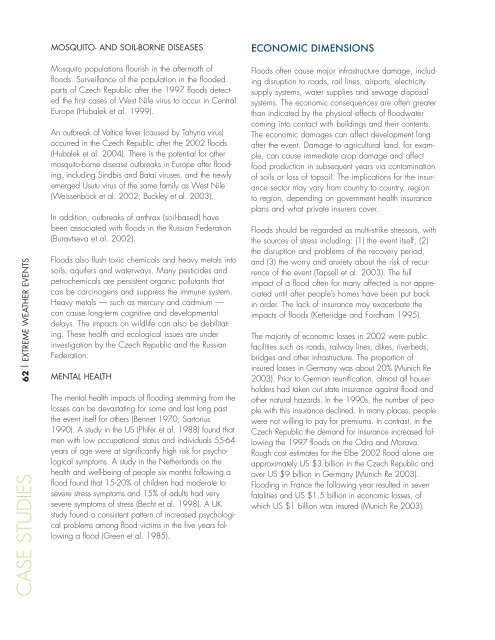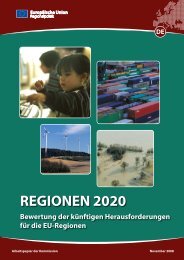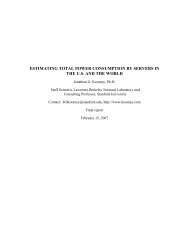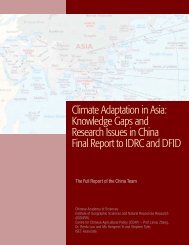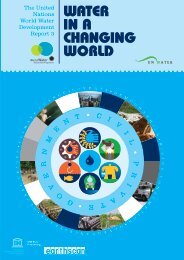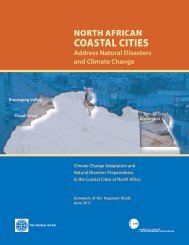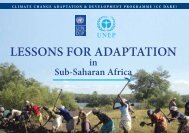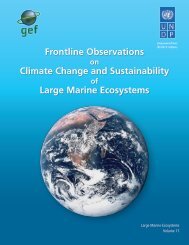Climate change futures: health, ecological and economic dimensions
Climate change futures: health, ecological and economic dimensions
Climate change futures: health, ecological and economic dimensions
Create successful ePaper yourself
Turn your PDF publications into a flip-book with our unique Google optimized e-Paper software.
MOSQUITO- AND SOIL-BORNE DISEASESECONOMIC DIMENSIONS62 | EXTREME WEATHER EVENTSCASE STUDIESMosquito populations flourish in the aftermath offloods. Surveillance of the population in the floodedparts of Czech Republic after the 1997 floods detectedthe first cases of West Nile virus to occur in CentralEurope (Hubalek et al. 1999).An outbreak of Valtice fever (caused by Tahyna virus)occurred in the Czech Republic after the 2002 floods(Hubalek et al. 2004). There is the potential for othermosquito-borne disease outbreaks in Europe after flooding,including Sindbis <strong>and</strong> Batai viruses, <strong>and</strong> the newlyemerged Usutu virus of the same family as West Nile(Weissenböck et al. 2002; Buckley et al. 2003).In addition, outbreaks of anthrax (soil-based) havebeen associated with floods in the Russian Federation(Buravtseva et al. 2002).Floods also flush toxic chemicals <strong>and</strong> heavy metals intosoils, aquifers <strong>and</strong> waterways. Many pesticides <strong>and</strong>petrochemicals are persistent organic pollutants thatcan be carcinogens <strong>and</strong> suppress the immune system.Heavy metals — such as mercury <strong>and</strong> cadmium —can cause long-term cognitive <strong>and</strong> developmentaldelays. The impacts on wildlife can also be debilitating.These <strong>health</strong> <strong>and</strong> <strong>ecological</strong> issues are underinvestigation by the Czech Republic <strong>and</strong> the RussianFederation.MENTAL HEALTHThe mental <strong>health</strong> impacts of flooding stemming from thelosses can be devastating for some <strong>and</strong> last long pastthe event itself for others (Bennet 1970; Sartorius1990). A study in the US (Phifer et al. 1988) found thatmen with low occupational status <strong>and</strong> individuals 55-64years of age were at significantly high risk for psychologicalsymptoms. A study in the Netherl<strong>and</strong>s on the<strong>health</strong> <strong>and</strong> well-being of people six months following aflood found that 15-20% of children had moderate tosevere stress symptoms <strong>and</strong> 15% of adults had verysevere symptoms of stress (Becht et al. 1998). A UKstudy found a consistent pattern of increased psychologicalproblems among flood victims in the five years followinga flood (Green et al. 1985).Floods often cause major infrastructure damage, includingdisruption to roads, rail lines, airports, electricitysupply systems, water supplies <strong>and</strong> sewage disposalsystems. The <strong>economic</strong> consequences are often greaterthan indicated by the physical effects of floodwatercoming into contact with buildings <strong>and</strong> their contents.The <strong>economic</strong> damages can affect development longafter the event. Damage to agricultural l<strong>and</strong>, for example,can cause immediate crop damage <strong>and</strong> affectfood production in subsequent years via contaminationof soils or loss of topsoil. The implications for the insurancesector may vary from country to country, regionto region, depending on government <strong>health</strong> insuranceplans <strong>and</strong> what private insurers cover.Floods should be regarded as multi-strike stressors, withthe sources of stress including: (1) the event itself, (2)the disruption <strong>and</strong> problems of the recovery period,<strong>and</strong> (3) the worry <strong>and</strong> anxiety about the risk of recurrenceof the event (Tapsell et al. 2003). The fullimpact of a flood often for many affected is not appreciateduntil after people’s homes have been put backin order. The lack of insurance may exacerbate theimpacts of floods (Ketteridge <strong>and</strong> Fordham 1995).The majority of <strong>economic</strong> losses in 2002 were publicfacilities such as roads, railway lines, dikes, riverbeds,bridges <strong>and</strong> other infrastructure. The proportion ofinsured losses in Germany was about 20% (Munich Re2003). Prior to German reunification, almost all householdershad taken out state insurance against flood <strong>and</strong>other natural hazards. In the 1990s, the number of peoplewith this insurance declined. In many places, peoplewere not willing to pay for premiums. In contrast, in theCzech Republic the dem<strong>and</strong> for insurance increased followingthe 1997 floods on the Odra <strong>and</strong> Morava.Rough cost estimates for the Elbe 2002 flood alone areapproximately US $3 billion in the Czech Republic <strong>and</strong>over US $9 billion in Germany (Munich Re 2003).Flooding in France the following year resulted in sevenfatalities <strong>and</strong> US $1.5 billion in <strong>economic</strong> losses, ofwhich US $1 billion was insured (Munich Re 2003).


